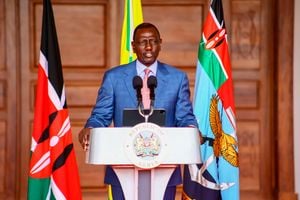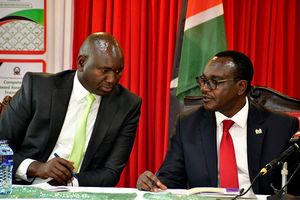
Higher Education and Research Principal Secretary Beatrice Inyangala cut a lonely and desolate image as she appeared before Parliament this past week to explain the mess that is the new university funding model. Dr Inyangala was clueless as she fumbled through the notes prepared by bureaucrats who seemed not to understand the issues.
At the same time, chaos reigned at the universities which started admitting freshers during the week as the administrators sent away thousands who had reported without fees.
This forced Education Cabinet Secretary Julius Migos to issue an order to the universities to admit the students without fees, itself a ridiculous and thoughtless response. It is dishonest to force universities to admit learners when there is no cash to keep them there.
Read: Cash and controversy: Student leaders reject Ruto's university funding model in State House talks
The trouble with the university financing is not really the model, but a broken higher education system. It is about university governance, policy and legal, financing and administrative architecture. Principally, the question is whether the government can effectively fund universities within the current legal, policy and administrative framework on higher education.
In the first place, the government has a poor plan for resource allocation exemplified by the fact that it has scattered outfits for sharing bursaries – ranging from the Higher Education Loans Board (Helb), University Funding Board to constituency and county bursary kitties. And this is what the National Assembly locked onto and recommended that the ministry formulates a policy to consolidate the kitties into one and from there fund university students.
Secondly, the operating governance framework where the President makes decisions on university education without expert advice is fraught with pitfalls. Under this set-up, universities are literally controlled from State House and Ministry of Education headquarters, rendering them incapable of planning and making independent decisions.
Related to this is the fact the universities are unable to fundraise or develop proposals for grants to sustain themselves as happens in other parts of the world.
Reliance on the state for funding and administrative decisions has rendered them mere appendages to the Executive, undermining their capacity to operate autonomously.
Granted, it is paramount to give a historical context of university education funding to debunk the falsehoods being peddled by government functionaries.
From independence in 1963 to 1974, the government offered free university education with the objective of creating a pool of human resources to drive the economy of a nascent state. However, with growing numbers of students seeking university education and declining economy, the government proposed in the 1974-1978 Development Plan to withdraw students’ grants and replace it with loans, which they would pay upon graduation.
While the loans scheme supported students and enabled them to acquire university education, the challenge was that the government did not have a mechanism for recovering the money.
This is why the government established Helb in 1995 and charged it with the task of giving loans and scholarships to students, recovering the money and creating a revolving fund to finance other university qualifiers.
For a period, Helb executed its mandate well at one time, was able to give loans and scholarships from its recoveries and subventions from government. But this became a challenge in recent years due to increased numbers of qualifiers against diminished recoveries and reduced government funding.
In all these years, the government allocated equal amounts to all university students. This became problematic because various courses have different costings.
The government then introduced a new model – differentiated unit cost (DUC) – to fund university education in 2016.
It involved working out the unit cost for every degree programme and allocating commensurate amounts for it. Courses like medicine, engineering and architecture – which are expensive to mount – were allocated more money compared to others such as humanities.
However, the DUC model quickly ran into headwinds because of the inability of the government to fund it.
For the few years it was implemented, the highest funding was in 2018/19 financial year when the government provided 66.4 per cent of the cash.
Progressively, this went down to a low of 48.1 per cent in 2022/23. Consequently, this pushed the universities to financial deficits.
Given this trend, there is no likelihood of the government doing anything better unless it looks critically at the issue and works out a proper plan devoid of histrionics. The National Treasury released Sh5.2 billion to Helb for loans and scholarships and another Sh2.8 to the universities on Wednesday, yet the annual budget for the loans and scholarships is Sh30 billion, according to the estimates by the ministry.
Understandably, the cash is disbursed in instalments, but from experience, the entire sums are never remitted to the universities.
As the debate rages, a critical issue that is being glossed over is how universities will be funding their operations if they admit students without fees. On their own, universities are cash-strapped and that is no longer news. Many universities are unable to pay salaries and already, the teaching and non-teaching staff have issued strike notices.
Facilities are so run down that some universities are in a pathetic state. In most universities, facilities like laboratories, workshops, hostels and ablutions are in horrible condition, far worse than those in secondary schools.
From the foregoing, it is puerile to talk of a new funding model that cannot even process applications from 150,000 students. As we saw in the past week, the mean-testing instrument is the cause of the students’ misery as it is fatally flawed.
As we have argued before, the starting point is to shelve this new model and think strategically on how to manage higher education, including governance, policy direction and then funding.
Among others, the ministry should fast-track the bill that proposes the scrapping of Helb, University Fund and Kenya Universities and Colleges Central Placement Service and creating single entity to manage funding.
Similarly, the government should stop creating new universities, merge some of the existing ones and rationalise programmes and staffing to reduce higher education expenditure.
David Aduda is Consulting Editor and Education Specialist.










